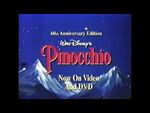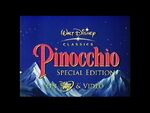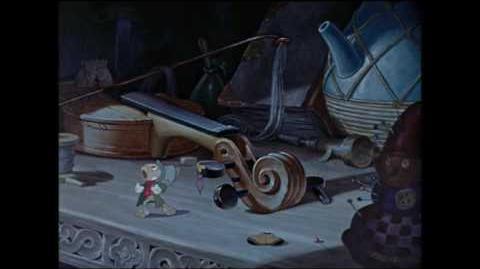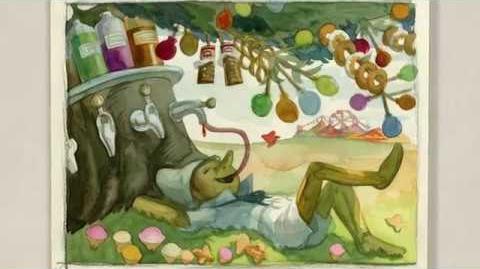This article is about the 1940 film. For the character, see Pinocchio (character).
Pinocchio is an animated musical comedy fantasy adventure film. The second film in the Disney Animated Canon, it was produced by Walt Disney Productions and originally released to theatres by RKO Radio Pictures on February 23, 1940.
Pinocchio was made in response to the enormous worldwide success of Snow White and the Seven Dwarfs. Based on the Italian book The Adventures of Pinocchio by Carlo Collodi, which is the second most translated book in the world, with over 300 translations. The film stars a puppet - brought to life by a fairy - who tries to earn his right to become a real boy, as he faces the challenges and dangers of a dark, hostile world of crooks, villains, and monsters.
It premiered in New York City on February 7 and in Los Angeles two days later. The film was then theatrically re-released in 1945, 1954, 1962, 1971, 1978, 1984, and 1992.
The song "When You Wish Upon a Star", became a major hit and is still identified with the film, and later as a fanfare for Walt Disney Studios itself. Pinocchio also won two Academy Awards for Best Original Song and Best Original Score. The film has been deemed "culturally significant" by the Library of Congress in 1994 and was thus selected for preservation in the United States National Film Registry. In the 2008 American Film Institute's "Top Ten Animated Feature Films of All Time" list, Pinocchio was ranked only behind Snow White and the Seven Dwarfs. In the decades since its release, the film has been widely considered by many film historians, critics, and pundits to be one of the greatest animated motion pictures ever made.
Plot
Jiminy Cricket opens the movie singing "When You Wish Upon A Star" as he sits on a bookshelf, on which various literary classics, such as Peter Pan, Alice in Wonderland, and the titular book can be found, and given a place of prominence. After the song ends, Jiminy greets the audience and acknowledges that many may not believe that a wish, as the song states, may come true, and, as proof of the message, decides to tell the story of Pinocchio. He slides down the shelf to the book and opens it, beginning his story in a peaceful village at night, which Jiminy states he was passing through. At this point, the viewer enters the story Jiminy is telling through an illustration in the book.
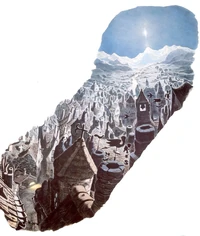
Pinocchio's village is introduced at night, with only Gepetto's workshop showing signs of activity. Inspirational sketch by Gustaf Tenggren.
The only building from which light seems to emanate is Geppetto's workshop. Jiminy hops over to the open window and peers in to see a warm fire in a room filled with beautifully carved toys, clocks, music boxes, and puppets. He enters the room and warms himself by the fire. He then notices a lifeless marionette puppet, sitting on a shelf. As he is admiring the puppet, he hears someone coming. Crawling up the marionette's strings to hide on a high shelf, he sees Geppetto coming down the stairs with Figaro to finish painting the puppet. Geppetto greets Cleo, whose bowl sits nearby, and carefully paints eyebrows and a smile on the puppet's face. Having completed the marionette he names it "Pinocchio" (which literally means "Little Wooden Head") and tests it out by walking it around the workshop, to the tune of Little Wooden Head which is played by one of the music boxes. The bells of the clocks that cover the walls of the workshop indicate that it is now nine o'clock, and Geppetto announces that it is time for bed. After he, Figaro and Cleo have bidden each other goodnight, the woodcutter gets into bed, to notice a Wishing Star through the window. He wishes that Pinocchio would become a real boy, before falling asleep.
While the others sleep, Jiminy however can't sleep with all the clocks in the workshop ticking and Geppetto, Figaro, and Cleo snoring away. He shouts for all to stop and goes back to sleep. Suddenly, the wishing star seems to glow and Jiminy starts to hide.
The wishing star glows brighter, and gets closer to the window; eventually, reaching the workshop, it transforms into the Blue Fairy, who is about to make a fateful spell out of Geppetto's wish. She approaches Pinocchio and brings the puppet to life with a tap of her wand, and his strings vanish without a trace. Pinocchio is delighted and surprised at his ability to move and talk. The Fairy informs him, however, that he is not a real boy yet, but must prove himself brave, truthful, and unselfish in order to become one and learn the difference between right and wrong. After Jiminy hops in to explain to Pinocchio, the Blue Fairy decides to dub the cricket Pinocchio's conscience and leaves, telling Pinocchio to always let his conscience be his guide.
Jiminy tries to explain the concept of right and wrong, and, though he is largely unsuccessful, Pinocchio tells him that he wants "to do right". Jiminy then sings "Give A Little Whistle", and Pinocchio joins in, falling into a pile of toys by accident. This wakes Geppetto, who cautiously searches the room. Upon finding Pinocchio moving and talking, he first thinks he is dreaming but is eventually convinced, and delighted, that his 'son' is alive. Winding the music boxes, Geppetto, Pinocchio, Figaro, and Cleo celebrate. Pinocchio is distracted by a candle and, not knowing what it is, accidentally sets his finger on fire; Gepetto panics and extinguishes the wooden boy's finger in Cleo's bowl. He decides that they should go to sleep before anything else happens.
The next morning, the village is awake. The boys and girls hurry to school, and Pinocchio excitedly follows them, but is approached by a fox and a cat, who, knowing the value of a moving puppet without strings, "befriend" him, intending to sell him. The fox introduces himself as Honest John and tells Pinocchio that he is just the type to become an actor. He and his partner Gideon (the cat) lead him through the streets, while Honest John sings "Hi-Diddle-Dee-Dee (An Actor's Life For Me)". Jiminy, meanwhile, is "late on his first day", and tries to tell Pinocchio not to give in to temptation, but is ignored, and Pinocchio accompanies the fox and cat to "be an actor" while Jiminy desperately runs after them.
Honest John takes Pinocchio to Stromboli's Caravan, where puppet master Stromboli buys the wooden boy and makes him his star attraction. That evening, Jiminy watches from a lamp post as Pinocchio performs "I've Got No Strings" for the audience, and is met with enthusiastic applause as onlookers throw money onto the stage, much to Stromboli's delight and Jiminy's surprise. Thinking that he was wrong in trying to stop Pinocchio, Jiminy decides to let the living puppet continue without him. Geppetto, meanwhile, is worried that Pinocchio has not returned from school, and leaves the workshop to look for him. In Stromboli's caravan, after the show, the puppet master congratulates Pinocchio for making him so much money and tells him that he will become a star. Delighted, Pinocchio tries to go home to tell Geppetto and promises to be back in the morning, but is stopped by Stromboli, who grabs him and throws him into a wooden birdcage as he declares that this will be his home. He tells the boy that he will keep him there, taking him out only to put on shows as they tour the world and make money for him. And when Pinocchio is too old to entertain audiences, Stromboli intends to use him for firewood. After silencing Pinocchio's request for his freedom, Stromboli leaves the carriage and slams the door, cackling. The caravan begins to move, and Pinocchio weeps as he tries to call out to his friend.
Jiminy is outside in the rain, watching the caravan pass. He decides to wish Pinocchio good luck and say goodbye to him and is surprised to find Pinocchio locked up. He tries to unlock the cage with his umbrella, but to no avail. He stays with Pinocchio as the two weep over their predicament. Geppetto passes the caravan, but his calls for Pinocchio are not heard over the rain and thunder. When all hope seems lost after Pinocchio has realized his mistake, the Blue Fairy appears in the caravan. She asks why Pinocchio did not go to school; the wooden boy lies, hiding his shame and telling her that he and Jiminy were captured by monsters. His nose becomes longer with each lie he tells until it becomes a tree limb, complete with leaves and a bird's nest. The Blue Fairy tells Pinocchio that a lie keeps growing "until it's as plain as the nose on your face" after she informs Pinocchio that he isn't telling the truth. Pinocchio promises to never lie again as Jiminy tells the Blue Fairy to give Pinocchio another chance, and his nose returns to its normal size. The Fairy frees Pinocchio from the cage and vanishes, saying that this is the last time she can help him. Jiminy and Pinocchio sneak out of the caravan as it is moving, leaving Stromboli unnoticed.
Meanwhile, Honest John and Gideon are celebrating at the Red Lobster Inn. Seated opposite them is the Coachman, who listens to their story and decides to catch their attention with a huge bag of money compared to the little and miserable one they got from Stromboli for Pinocchio, which he says can be theirs if they bring "stupid little boys" to the crossroads for him to take to Pleasure Island. Though Foulfellow is at first terrified of getting caught by the law, the Coachman assures him that none of the boys ever come back "as boys." As soon as they leave the tavern, desperate to find anyone in the empty streets, the fox and cat find Pinocchio racing Jiminy Cricket home while Pinocchio is going home to begin a fresh start tomorrow. Foulfellow and Gideon pretend to be doctors, stating that he is "allergic" and must go to Pleasure Island to get better. They carry him to the crossroads with Jiminy once again in hot pursuit. While on the Coachman's Stagecoach, Pinocchio meets a bratty kid named Lampwick, who tells him that Pleasure Island is a "swell joint" where boys can run riot without fear of reprimand from authority figures and everything is freely available. The coach reaches the shore, where the boys board a boat which takes them to the island. Many of the attractions on Pleasure Island include Rough House, American Indians Tobacco Row, Model Home for Destruction which the boys in the crowd indulge in including fighting, vandalism, drinking alcohol and smoking cigars.
As the boys enjoy themselves at the fairground-like Pleasure Island, the Coachman orders his minions to close the doors, locking the unknowing boys in. Later, after an unspecified time, Jiminy searches the now-deserted fairground for Pinocchio. He eventually finds him playing pool with Lampwick, who scoffs that Pinocchio "takes orders from a grasshopper" after Jiminy tells Pinocchio that he has to come home right now and Lampwick laughing at Jiminy, shooting the cricket down the pool gutter when he admonishes him. This causes Jiminy to lose his temper and attempts to leave, quitting as Pinocchio's conscience once again after discovering that Pinocchio is friends with Lampwick. He crawls under the main doors of the fairground to find the Coachman and his minions loading donkeys into crates going to places, such as the Salt Mines and the Circus. One donkey, named Alexander, is able to speak. The Coachman throws Alexander into a pen of the other donkeys that "can still talk". Alexander and the other donkeys who can still talk, cry and beg for their freedom and to be human again, only for them to be silenced by the Coachman with a harsh whip crack and telling those transformed boys that they've already had their fun and now have to pay for it (which indirectly imparts to Jiminy the knowledge that Pinocchio needs to escape). When Jiminy hears this, he realizes that those donkeys are actually the same boys who went to Pleasure Island, prompting the cricket to panic and rush back to warn Pinocchio. Back in the pool hall, Lampwick is still laughing and mocking about Jiminy by saying that something is going to happen to them when he suddenly sprouts donkey ears, a tail, and his head is transformed into a donkey's. Lampwick asks if he looks like a jackass and Pinocchio replies that he does and laughs about it with a bray in his laugh. Lampwick tells him that he laughs like a donkey then he laughs with a bray in it too. He asks Pinocchio if that came out of him and Pinocchio frantically nods his head. He then feels his furry nose, cheeks, and long donkey ears, starts panicking, and then looks into the mirror and panics even more after witnessing the changes. He begs Pinocchio for help, but the boy is only able to look on in fright as Lampwick's hands turn into donkey hooves. Lampwick's last words are a frantic call for his mother before he loses the ability to talk, completing the donkey transformation. Running in a great panic, Lampwick starts to kick everything in the pool hall, breaking the mirror and tables, and shaking his clothes off. A speechless Pinocchio hides behind a chair and his panic increases when he himself sprouts donkey ears and a tail. Jiminy arrives to tell Pinocchio that Pleasure Island is cursed as the boys are all donkeys and sees he's partly a donkey now too, then frantically tells him they must leave quickly before he gets any worse. They hurriedly take an escape route in order to avoid the same terrible fate as all the other boys. Together, they jump off Pleasure Island and swim to the shore of the mainland with Pinocchio only having a donkey tail, ears, and bray in his laugh leaving the now-transformed Lampwick, the transformed boys, the Coachman, and his minions behind.
Meanwhile, Pinocchio and Jiminy arrive at Geppetto's workshop to discover it deserted and full of dust and spiderwebs since the old woodcutter has left, along with Figaro and Cleo. A message delivered by the Blue Fairy as a dove informs Pinocchio of his father's location: after venturing out to sea to find Pinocchio, he had been swallowed by Monstro, an enormous whale. Pinocchio resolves to save his father; though Jiminy tries to warn him against it, he accompanies the boy. Tying a rock to his donkey tail, Pinocchio plunges to the bottom of the sea and he and Jiminy begin their search for Monstro. Any sea creatures they attempt to ask flee at the mere mention of his name.
Inside the belly of the whale, Geppetto is in a small boat with Figaro and Cleo. They have nothing to eat; Geppetto fears that, unless Monstro opens his mouth soon, they will starve to death. He then wakes from his slumber to surprise a school of tuna, who flee in all directions; Pinocchio and Jiminy see Monstro and, frightened, try to swim to escape; Pinocchio is swallowed alongside the tuna, but the sprightly Jiminy manages to escape, though he is unable to get Monstro to reopen his mouth as the whale has fallen asleep again. Pinocchio finds himself on Geppetto's boat, and the woodcarver is relieved to see his son again. Geppetto laments that they could not get out of the whale. However, Pinocchio has a plan; gathering some wood, he starts a fire, which causes Monstro to sneeze the raft out. Jiminy jumps on as they fly past. Furious, Monstro chases the raft and smashes it to pieces with his tail. Pinocchio grabs ahold of his father and paddles for a hole in the cliffs beyond as a means of escape. Monstro, infuriated as ever, continues to chase after them. Pinocchio succeeds in getting through the hole in the cliff just as Monstro crashes into it. Geppetto, Jiminy, Figaro, and Cleo wash up on shore alive, but Pinocchio is seen floating face down in a deep puddle, apparently having died while trying to save his father.
In Geppetto's workshop, Jiminy, Geppetto, and his pets mourn Pinocchio's death. However, for saving his father, Pinocchio has proved himself brave, truthful, and unselfish; the Blue Fairy, from afar, grants him life, and he becomes a real boy (the donkey ears and tail disappear). Pinocchio shows the others that he is alive and a real boy, and everybody begins to celebrate once again. While the others celebrate, Jiminy, standing on the window ledge, gazes at the Wishing Star and thanks the fairy. As a reward, a gold medal declaring him an "Official Conscience" appears on his coat. The Wishing Star shines in the sky, protecting and illuminating the village forever as the film closes with "When You Wish Upon a Star".
Cast (all uncredited)
- Dickie Jones as Pinocchio
- Cliff Edwards as Jiminy Cricket
- Christian Rub as Geppetto
- Walter Catlett as J. Worthington Foulfellow
- Mel Blanc as Gideon, and Donkeys
- Charles Judels as Stromboli, Coachman, and Native American Statue
- Evelyn Venable as Blue Fairy
- Frankie Darro as Lampwick
- Don Brodie and Lindsay MacHarrie as Carnival Barkers
- Billy Sheets as The Roughhouse Statue
- Clarence Nash as Figaro, and Donkeys
- Thurl Ravenscroft as Monstro
- Tex Gilmore, Lee Millar and Clarence Straight as Donkeys
- Marion Darlington as the birds and the whistling saw
- Joey Pennario as Alexander
- Earle Hodgins as Clown
- Patricia Page as Dutch Puppet, French Puppet and Russian Puppet
- Virginia Davis and Don Orlando as Additional Voices
Production
Story development
- “I take the liberty of calling to your attention again to the use of the language and the pronunciation... It is a masterwork full of episodes and fit to be developed.”
- ―Lo Duca in a letter dated July 4, 1935
It's clear that Walt Disney had been aware of Pinocchio long before deciding to adapt it for animation; Roy E. Disney recalled his uncle reading the story to him before bed. However, Disney does not seem to have considered it for a feature until it was suggested by Ben Sharpsteen. Mrs. K. Evers, a family friend, suggested it for a short subject in a letter of April 8, 1935. On his holiday in Europe Disney had met Lo Duca, an Italian journalist, who was similarly enthusiastic that Disney adapt it, urging him that it was 'fit to be developed' in a letter. The title Pinocchio had been registered as a feature in May 1934. Collodi's original story, Le avventure di Pinocchio first appeared in serial form in 1881, and was published as a book in 1883. An English translation of story was published in America in 1911. Walt Disney owned the original Italian edition and several different English translations of the tale, and in 1937 Bianca Majolie, a member of the story department, made a new translation. A play by Yasha Frank, based on the original story, was published in 1939 but performed earlier; Disney circulated a memo on June 9, 1937 recommending that his artists will see the play, and consider it as material for a feature. However, due to the pressure to complete Snow White and the Seven Dwarfs, story meetings for Pinocchio do not appear to have begun until March 24, 1938. Story work for Bambi was begun in 1937, before the release of Snow White and the Seven Dwarfs and earlier than that of Pinocchio. Thinking that the animal characters of Bambi would be easier to animate than the predominantly human cast of Pinocchio, Disney expected Bambi to be completed first. By December 1937, however, it seemed Pinocchio would be the first to be ready for release.
It is thought that Walt showed less enthusiasm in story meetings for Pinocchio than in those for Snow White. Anxious to increase the output of his studio - he intended at this point to release, in addition to short cartoons, two or more features every year - he seemed eager to move onto the animation stage as quickly as possible. As a result, the story was split into sections; The first, consisting of scenes introducing Pinocchio, Geppetto, Figaro, and the Blue Fairy, was prepared in a scene-by-scene format. Animation began in early 1938. It was not until February of that year that Disney began to show more interest, finding potential in the scenes featuring Monstro the whale.
The Character of Pinocchio
The story men found Collodi's original story difficult to adapt. Originally written in serial form, the story was, as a result, episodic and needed to be cut down considerably in order to work as a feature film. The primary problem, however, was the protagonist; Pinocchio himself was an impudent rogue, often guilty of cruelty in the original story. His wooden body would surely make the character even less sympathetic with audiences. In early story treatments for the film, Pinocchio retains his malice, at one point trapping Figaro's tail in a vice. Emphasis was also placed on the boy's wooden body, as he was teased for his appearance by boys, and sniffed at by a curious dog, on the way to school. As animation had, by this time, begun, but no voice had yet been found, animators Frank Thomas and Ollie Johnston worked from the sped up voice of story man Ted Sears, intended as a temporary measure. However, Disney was still unhappy with the character of Pinocchio and halted production until a solution could be found. The degree of humanity in the living puppet had yet to be determined and fine-tuned. In early April 1938, however, scenes featuring other characters had been written and were being animated.
Though Fred Moore had attempted to design Pinocchio in a more appealing way, it was Milt Kahl who was responsible for the character's redesign. Kahl approached the character as though he was an ordinary boy, rather than a wooden puppet; the joints and nails could simply be drawn in afterward. At the request of Hamilton Luske, Kahl illustrated his ideas by animating the scene in which Pinocchio dives into the sea in search of Monstro. The little wooden boy became less mischievous and more passive, wandering innocently into the hostile world that awaited him. Though Disney himself found this to be an excellent idea, giving the go-ahead for the opening scene's animation to be continued in September, some were unsure, including Wilfred Jackson, who would later admit that the change removed 'the guts of the whole story', as a more human Pinocchio in his puppet form made his transformation into a real boy less gratifying. The Disney Studio debated about including a winter scene or a full-fledged scene featuring Christmas in the animated feature Pinocchio (1940). From a January 6, 1938 story meeting, Walt Disney said, "That's the trouble – the exhibitors will class it as a Christmas picture and only run it at Christmas time. Well, Heidi had Christmas in it – they had quite a sequence there of Christmas...It doesn't matter, we were just trying to get something pictorial in here."
Design
Inspirational Sketch Artists
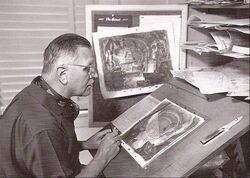
Albert Hurter working on the design of Pinocchio in 1939.
As with Snow White and the Seven Dwarfs, Albert Hurter designed the characters, objects and locations featured in Pinocchio, and was responsible for the overall styling of the film. Hurter's influence are particularly apparent in the scenes in Geppetto's Workshop, in which nearly every object is designed to resemble a face or creature of some sort; every object in the workshop was designed by Hurter, then realized as a three-dimensional (often working) model. However, the inspirational sketch artist whose style is perhaps most prevalent in the final film was Gustaf Tenggren, who had already made his name as an illustrator before joining the studio in 1936. Tenggren reinforced the influence of European Illustration on the film (having worked as successor to John Bauer for the magazine Bland Tomar och Troll); he also kept files and cuttings on favourite American painters (such as Thomas Hart Benton, Grant Wood, and Edward Hopper) and shots from Hollywood films.
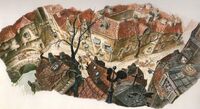
Gustaf Tenggren's inspirational sketch of an aerial view of the village demonstrates the influence of American painters and Hollywood films of the time.
These influences can be seen in Tenggren's inspirational sketches for the film, in which composition is made dynamic by a 'fish-eye lens' effect, depth is emphasized by exaggeration of perspective, and figures and buildings are characterized by sharpened, immaculate edges. During his time at the studio, Tenggren did not socialize with the other artists and animators, who felt that the talented artist was too proud to want to compromise on the styling of the film. Tenggren left the studio a year before the film's release and, controversially, received no credit for the film; despite this, he is generally considered (with the possible exception of Mary Blair) to be the most influential artist on the visual style of Disney's films.
The Character Model Department
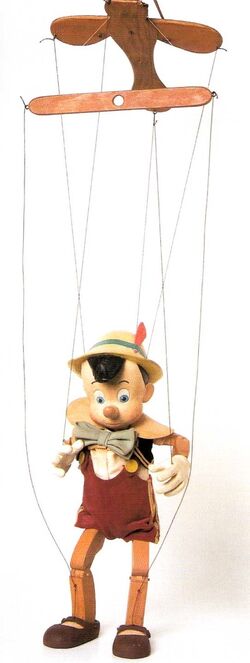
A working Pinocchio marionette constructed as reference for the animators.
Joe Grant had designed both The Evil Queen and her alter-ego, the Witch, and had been responsible, along with William Cottrell, for both characters' scenes in Snow White and the Seven Dwarfs. During production on Snow White, several crude models - including armatures for the dwarfs and a plastic Snow White head - had been constructed as reference for the animators. Grant's more detailed plastic model of the Witch did not go unnoticed by Walt Disney, who, when passing him in a studio hallway one day, asked him to "set up a little department": a "think tank" which would be responsible for the design and construction of models for use by the animators and their assistants. Interestingly, Disney did not include Cottrell in his proposal; it is thought that separating the team of Grant and Cottrell was intended as a reassertion of Disney's power.
In setting up the Character Model Department, Grant recruited the studio's best artists; over the years the department included, among others, Jack Miller, Bob Jones, Martin Provenson, Cambell Grant, John Wallbridge, Fini Rudiger, Tom Codrick, Mary Blair, Aurelius Battaglia, James Bodrero, Kay Nielsen, and Albert Hurter. Most artists would produce sketches and model sheets. At Disney's suggestion, eventually three-dimensional models were constructed. Charles Christadoro, Ted Kline, Lorna Soderstrom, and Duke Russell were responsible for sculpting the clay models; these models were then fired in a kiln in Grant's own backyard, and painted by women from the Ink and Paint Department, including Helen Nervobig. Models were constructed of every character, including Pinocchio as a marionette, as well as Stromboli's Caravan, The Coachman's Stagecoach, and all of Geppetto's Toys and Clocks. Many model sheets were also produced with designs for the fish Pinocchio encounters in the sea. The artists of the Character Model Department were also responsible for developing ideas, and were heavily involved with the story development of Pinocchio and many of the segments in Fantasia.
Next to Disney himself, Grant was the most powerful man in the studio during production on Pinocchio and Fantasia; he was increasingly relied on to make creative decisions and was determined to "appeal to Walt to stimulate him and to raise (himself) in his esteem." All sketches and model sheets had to by stamped 'O.K. J.G.' (indicating Grant's approval of the design) before being used by the animators. The animators did not regard the Character Model Department fondly, often angry both at Walt's increased attention paid to it and what they believed to be very little effort put in on the part of the artists, "who could sit and whistle and make a pretty thing without much effort". Grant's department, correspondingly, saw the animators as "a hundred percent yokel". The disdain shown by each group for the other increased at the construction of the expensive new Burbank studio, which placed the Character Model Department on the third floor (near Disney's office) and the animators, on the first.
Reception and Critical Reaction
Upon its 1940 release, Pinocchio was not financially successful. Mainly due to World War II cutting off European and Asian markets overaseas. However, others think it was too dark for being a film for family audiences. While there are also clear dark elements in Snow White and the Seven Dwarfs, these evil forces are vanquished in the film's climax; in comparison, four of the villains of Pinocchio (Honest John, Gideon, Stromboli, and The Coachman) continue their deeds unpunished, or at least basing on what is seen on-screen and leaving their fates open to deduction and interpretation of the viewers (even Monstro's fate is ambiguous and not clear and sure). It is thought by some that the use of multiple villains in the film is a reflection of complexity of the Depression (following the Second World War, most Disney films would be characterized by a single villain). The dark themes of the film are also thought to be a result of the film's European sources, particularly Collodi's original story (the darkness of which Disney nevertheless attempted to lessen in his adaptation) and a mise en scene heavily influenced by German Expressionism. Intense sequences, such as Stromboli's imprisonment of Pinocchio, Lampwick's transformation, and Monstro's scenes, were deemed particularly frightening for young audiences. The Second World War had cut off Disney's European market, preventing the exhibition of Pinocchio (and, later that year, Fantasia) in Europe. It has been speculated that this cut off an audience which may have been more ready to accept the film more than Americans, given the film's strong European influences.
Despite not being initially a commercial and financial success, the film remains one of the most critically acclaimed of all the Disney animated features. Archer Winsten, who had been critical of Snow White and the Seven Dwarfs, had nothing but praise for Pinocchio. The New Yorker's review was similarly positive, arguing that "it befits us to take Pinocchio to our hearts with gratitude and pleasure." While many audiences complained about the absence of a romance, some critics praised the film for staying away from over-sentimentality. Richard Mallett (Punch) wrote, "is it better than Snow White and the Seven Dwarfs? I think it is, much better, not in spite of (as at least one reviewer said) but partly because of the absence of so much conscious sentiment and charm." The film is also considered the most technically brilliant film in the Disney animated features canon. Review aggregator website Rotten Tomatoes reports that 100% of the critics gave the film a positive review based on 41 reviews. Pinocchio is one of the handfuls of films to achieve a 100% "Fresh" rating on Rotten Tomatoes.
Release
- Main article: Pinocchio (video)
Differences from source material
- In the book, the titular character, Pinocchio, is depicted as a much more ill-behaved character whom is bratty, rude, self-centered, and obnoxious in personality, only learns his lessons by suffering from constant physical and psychological abuse and freak accidents (which seemed to justify how the villains didn't got karma) until he finds his total redemption by rescuing Geppetto and nursing back to heath while working at a farm, and has a more wooden-like appearance. In the film, however, the character's personality has been reworked into a much more innocent and good-natured character, and he has a much more human-like appearance despite being a wooden puppet.
- Geppetto was bald and used a yellow wig to cover his baldness. Geppetto in the film instead has a full head of grey hair. Also, Geppetto has a red nose that presumably was taken from another woodworker on the book, Maestro Antonio, who was nicknamed Maestro Cherry due to it.
- In the film Geppetto is in a much better economical status than his book counterpart, who couldn't even afford to light fireplaces and had to sell his jacket to get a schoolbook for Pinocchio.
- In the original story, The Talking Cricket and Pinocchio did not get along. The Cricket actually dies early on when he tries to lecture Pinocchio on his bad behavior, only to have the puppet accidentally crush him with a hammer. He reappears later on as an equally preachy ghost, then inexplicably reappears alive again towards the end.
- In the original story, Geppetto actually gets arrested through some meddling townsfolk who misinterpret his attempts to discipline the naughty Pinocchio for child abuse. This does not happen in the Disney version.
- Stromboli was originally called "Mangiafuoco" ("Fire-Eater"), and despite his terrifying appearance, was capable of kindly impulses, like sparing with Pinocchio and sympathizing with him when he knew about Geppetto's poverty. The Italian dub names him Mangiafuoco.
- The fairy was usually referred to as the fairy with blue hair (turquoise actually), and there was no indication she was responsible for Pinocchio coming to life. Also she had a entourage of intelligent animals at her command, including a poodle who acted as her coachman, a team of mice to pull her coach, and a snail who acted as her housekeeper and messenger.
- While Geppetto had a nameless cat in the book, he never had a fish, and therefore Cleo does not have a book counterpart.
- Honest John and Gideon (who were unnamed in the original and called as "The Fox and the Cat") just trick Pinocchio into planting some coins "Stromboli" (Mangiafuoco) has given to him, making him believe it would create a money tree in the Field of Miracles. Also, it is not mentioned that they work with the Coachman.
- Pleasure Island was originally called "Toyland" ("Il Paese dei Balocchi").
- In the original story, Pinocchio became a complete donkey and gets sold to a circus where, once that he hurt his leg, he gets sold to a man who tosses Pinocchio into the sea with the purpose of drowning him and using his donkey skin to make a drum once dead, but Pinocchio gets saved by his fairy who sends a school of fish to eat his donkey skin off and thus turning him back into a wooden puppet.
- The film mentions donkeys being sold to salt mines and a circus.
- Differently from the movie, in the book the fates of the Fox and the Cat and Lampwick (or "Lucignolo" in the original Italian version or "Candlewick" in most English translations) are clearly depicted: the first two, by pretending to be blind and crippled all the time, they became invalid for real and also without any money, while Lampwick got sold to a farmer, where he died from hard work (the irony in all three's fates is deliberate and makes the reader think).
- It was a giant shark or dogfish, not a whale, that swallows Geppetto and then Pinocchio in the original story. This makes Monstro in the film a much less neutral character than his original counterpart, considering the actual nature of the whales in real life.
- In the book, Pinocchio and Geppetto get to leave the shark's belly peacefully, although needing the help of a tuna to reach the shore. This changes the context where Pinocchio becomes a real boy. In the book, he does after the Fairy sees him becoming hardworking for his father and for her, while in the film it is tied to his sacrifice to get Geppetto and the rest released from Monstro's belly.
- The original was much darker than the film. Pinocchio was actually used to describe how the author felt about naughty children. Pinocchio got harmed a lot and at one point was even hanged by the Fox and the Cat. However the author was forced to continue the story, using as an excuse that Pinocchio has no lungs, so he survived the hanging.
- The movie cut a lot of scenes from the original book, sticking with the short version of the story that exclude all the things Pinocchio meets after the Fox and the Cat but before going to Toyland (like the Green Fisherman, the Busy Bee Island, the Ape Judge, the Snake, and more).
Allusions
- Two books labeled Alice in Wonderland and Peter Pan are visible in the very first shot of the film. Alice in Wonderland was released 11 years after Pinocchio, with Peter Pan immediately following two years later. Seventy years after the release off Pinocchio, in 2010, another Disney adaptation of Alice in Wonderland would be released and become a billion dollar grossing Tim Burton blockbuster starring Mia Wasikowska and Johnny Depp.
- The clock with the mother spanking the child with a bucket of paint on his hand is inspired by a 1931 cover from The Saturday Evening Post that depicts a older woman spanking a boy with paint on his face with her shoe.
Videos
Gallery
Trivia
- The film's copyright was renewed on March 28, 1967.[1]
- To this day, it remains debatable who is the main antagonist: Honest John, Stromboli, the Coachman, or Monstro.
- The main song "When You Wish Upon A Star" was parodied in the Family Guy episode "When You Wish Upon A Weinstein", where Peter Griffin sings "I Need A Jew" when he foolishly spends his family's savings on volcano insurance and asks for financial help. Walter Murphy and Seth MacFarlane were sued by the owner of the rights to the song. This song also featured in Wishes at Magic Kingdom and Remember... Dreams Come True at Disneyland.
- The film is also parodied in The Simpsons episodes "Itchy & Scratchy Land" and "When You Dish Upon a Star" (episode title only).
- Pleasure Island's name may have been a play on Treasure Island, a novel by Scottish author Robert Louis Stevenson, which incidentally inspired the films: Treasure Island, Muppet Treasure Island, and Treasure Planet.
- Pinocchio is the first and, until the release of The Sword in the Stone, the only Disney theatrical release to include a storybook opening, but leave out a storybook closing.
- The Platinum Edition and the Signature Collection release use the original RKO Radio Pictures logo at the start and the 2006 Walt Disney Pictures logo, with the latter logo with just Disney at the end.
- This is the second Disney animated classic to have the 2006 Walt Disney Pictures logo at the end of the movie, on current releases.
- This is one of the few Disney movies that lacks timelessness when it comes to audio, due to the fact that old 1930's language phrases aren't used in common speech anymore. Phrases such as, "bloke", "swell joint", "scrape", or "hopping to it" are used in the film, and the most infamous example being "An actor's life is gay" in lyrics of "Hi-Diddle-Dee-Dee". Back in 1930s and up to 1950s, the word "gay" meant happy. It also applies to some other language versions.
- In the 24-paged book related to the movie by Bendon Publishing, all references of tobacco and alcohol are omitted due to legal disputes against the depiction of drugs in children's media. This also omits the word "jackass" from this publication as it is considered inappropriate language to the young readers, in spite of the word meaning "donkey", along with "stupid" or "idiot".
- The fate of every antagonist in the film is not seen on-screen or clarified, it can be only deduced or interpreted by the viewers.
- Monstro is the only antagonist who gets any sort of final comeuppance onscreen, although even in his case his ultimate fate is left unclear. Honest John and Gideon conned Pinocchio and were never seen again afterwards (though in a deleted scene, they were taken into police custody by the law enforcement), Stromboli presumably left the town with his caravan, and the Coachman was last seen locking up the kids turned donkeys on Pleasure Island to sell them into slavery.
- There are few clues that further and strongly suggest that also Honest John and Gideon got a final comeuppance off-screen like Stromboli and Monstro, whether they got arrested or have been running from the law:
- Geppetto found out of Pinocchio's location on Pleasure Island, and the only ones who could know this were the aforementioned two crooks or the villagers who may have heard them taking Pinocchio to the coach at the crossroads (in an early draft and concept art, Geppetto turned to the police and a gendarme while searching for Pinocchio in the streets).[2][3][4][5]
- Alternatively, Pinocchio escaped from Pleasure Island, the only boy who made it, and this was the biggest fear of Honest John back at the Red Lobster Inn.
- The Blue Fairy transformed Pinocchio into a real boy as a reward for being "truthful". There's no scene on-screen in the movie that shows this, so this implies that Pinocchio told Geppetto the whole story of his misadventures off-screen while in the Monstro's belly before planning to escape. In fact, various events happen off-screen in the movie and in many films of the Walt Disney's era, usually to focus as much as possible on the protagonists.
- In 1987, animation studio Filmation released a film titled Pinocchio and the Emperor of the Night. While it is technically an original film, many viewed it as a "thinly-veiled" sequel to the 1940 classic, including Disney who opted to sue Filmation. They lost the lawsuit however, as Pinocchio is in the public domain. Disney had the last laugh anyway as the film was both a critical and commercial failure, but did gain a cult following over the years.
- This is the first Walt Disney Animation Studios film to use mild language ("jackass" being used thrice).
- Although Maestro Cherry, who in the original book is the woodworker who finds the log that eventually becomes Pinocchio, is an absent character in the film, he is mentioned several times by Geppetto in the video game Disney Magic Kingdoms, referring to him as his neighbor.
- Three of the Pleasure Island attractions shown on Pleasure Island include Rough House, Native American's Tobacco Row, Model Home for Destruction.
References
- ↑ Catalog of Copyright Entries (1967 renewals)
- ↑ David Koenig, Mouse Under Glass: Secrets of Disney Animation and Theme Parks. ISBN 0-9640605-0-7 "Geppetto, Figaro, and goldfish Cleo, sailing over the choppy Sea to rescue Pinocchio, take a short cut through the Narrows; it's dangerous but they have to get there quickly. Within sight of Pleasure Island, Geppetto says, Nothing can stop us now!, when they are swallowed by Monstro, guardian of the Terrible Straits."
- ↑ https://youtu.be/Lhj9SZw-jBk?si=oKuFN9UeerjJ9Trz | 14:37
- ↑ https://youtube.com/shorts/p-3rXuobSME?si=oH-OMeK8DiJvTyf1
- ↑ https://vegalleries.com/art/walt-disney/134/pinocchio-1940/pinocchio-photostat-model-sheet-id-janmodel20245
External links
 Pinocchio (1940 film) on Wikipedia
Pinocchio (1940 film) on Wikipedia Pinocchio (film) on IMDb
Pinocchio (film) on IMDb Pinocchio (film) on Disney.com
Pinocchio (film) on Disney.com- Pinocchio on Lux Radio Theater: December 25, 1939. Adaptation of Disney film.
- Pinocchio at the Big Cartoon DataBase
| v - e - d | ||||||||||||||||
|---|---|---|---|---|---|---|---|---|---|---|---|---|---|---|---|---|
|








